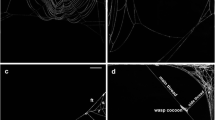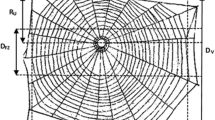Summary
Uloborids that spin reduced webs more actively monitor them than those that construct orb webs. Hyptiotes use both their first and fourth legs to tense their triangle-webs, whereas Miagrammopes rely principally on their first legs to monitor and jerk the threads of their irregular webs. The respiratory systems of these spiders include tracheae that extend into the prosoma, bifurcate, and enter the legs. To determine if the legs responsible for active web-monitoring tactics have more extensive tracheal supplies, the total cross sectional area has been computed of the tracheae entering the legs of mature female orb web and reduced web uloborids. Each leg's value has been divided by the cross sectional area of the tracheal trunks that enter the prosoma. These indexes reveal no significant differences between the relative tracheal supplies of the orb weavers investigated (Waitkera waitkerensis, Tangaroa beattyi, Uloborus glomosus). But the first, third, and fourth legs of H. cavatus and the first legs of M. animotus and M. pinopus have greater relative tracheal supplies than those of the three orb weaving species. Relative to leg volume, the first and fourth legs of H. cavatus have the greatest and the first legs of Miagrammopes species the next greatest tracheal supplies. When tracheal lengths are considered, these differences in potential oxygen supplies remain, showing that area differences do not simply compensate for differences in the distances over which oxygen must diffuse. These differences are leg-specific and not species-specific, and uloborids with the most extensive tracheal supplies are found in moist habitats. Thus the observed differences are best explained as adaptations to meet the greater oxygen demands of legs responsible for active web-monitoring tactics and not as adaptations to reduce respiratory water loss.
Similar content being viewed by others
References
Anderson JF (1970) Metabolic rates of spiders. Comp Biochem Physiol [A] 33:51–72
Anderson JF, Prestwich KN (1975) The fluid pressure pump of spiders (Chelicerata, Araneae). Z Morphol Tiere 81:257–277
Anderson JF, Prestwich KN (1980) Scaling of subunit structures in book lungs of spiders (Araneae). J Morphol 165:167–174
Blest AD (1976) The tracheal arrangement and the classification of linyphiid spiders. J Zool 180:185–194
Cloudsley-Thompson J (1957) Nocturnal ecology and water regulations of the British cribellate spiders of the genus Ciniflo. J Linn Soc London 43:133–152
Davis ME, Edney EB (1952) The evaporation of water from spiders. J Exp Biol 29:571–582
Dresco-Derouet L (1960) Etude biologique comparée de quelques espèces d'Araignées lucicoles et troglophiles. Arch Zool Exp Gen 98:271–354
Forster RR (1970) The spiders of New Zealand: III. Otago Mus Zool Bull 3:1–184
Levi HW (1967) Adaptations of respiratory systems of spiders. Evolution 21:571–583
Levi HW, Kirber WM (1976) On the evolution of tracheae in arachnids. Bull Brit Arach Soc 3:187–188
Lubin YD (1986) Web building and prey capture in Uloboridae. In: Shear WA (ed) Spiders: webs, behavior, and evolution. Stanford University Press, Stanford, pp 132–171
Lubin YD, Eberhard WG, Montgomery GG (1978) Webs of Miagrammopes (Araneae: Uloboridae) in the neotropics. Psyche 85:1–23
Millidge AF (1984) The taxonomy of the Linyphiidae, based chiefly on the epigynal and tracheal characters (Araneae: Linyphiidae). Bull Brit Arach Soc 6:229–267
Millidge AF (1986) A revision of the tracheal structures of the Linyphiidae (Araneae). Bull Brit Arach Soc 2:57–61
Opell BD (1979) Revision of the genera and tropical American species of the spider family Uloboridae. Bull Mus Comp Zool Harv Univ 148:433–549
Opell BD (1982) Post-hatching development and web production of Hyptiotes cavatus (Hentz) (Araneae: Uloboridae). J Arach 10:185–191
Opell BD (1984a) Phylogenetic review of the genus Miagrammopes sensu lato (Araneae: Uloboridae). J Arach 12:229–240
Opell BD (1984b) Comparison of the carapace features in the family Uloboridae (Araneae). J Arach 12:105–114
Opell BD (1985) Force exerted by orb-web and triangle-web spiders of the family Uloboridae. Can J Zool 65:580–583
Opell BD (1987) Changes in web-monitoring forces associated with web reduction in the spider family Uloboridae. Can J Zool 65:1028–1034
Opell BD, Eberhard WG (1984) Resting postures of orb-weaving uloborid spiders. J Arach 11:369–376
Peters HM (1938) Uber das Netz Der Dreieckspinne, Hyptiotes paradoxus. Zool Anz 121:49–59
Platnick NI (1977) The hypochiloid spiders: a cladistic analysis with notes on the Atypoidea (Arachnida, Araneae). Am Mus Novitates 2627:1–23
Schmidt-Nielsen K (1979) Animal physiology: adaptation and environment, 2nd edn. Cambridge University Press, London
Wilson RS, Bullock J (1973) The hydraulic interaction between prosoma and opistosoma in Amaurobius ferox (Chelicerata, Araneae). Z Morphol Tiere 74:221–230
Author information
Authors and Affiliations
Rights and permissions
About this article
Cite this article
Opell, B.D. The influence of web monitoring tactics on the tracheal systems of spiders in the family Uloboridae (Arachnida, Araneida). Zoomorphology 107, 255–259 (1987). https://doi.org/10.1007/BF00312171
Received:
Issue Date:
DOI: https://doi.org/10.1007/BF00312171




